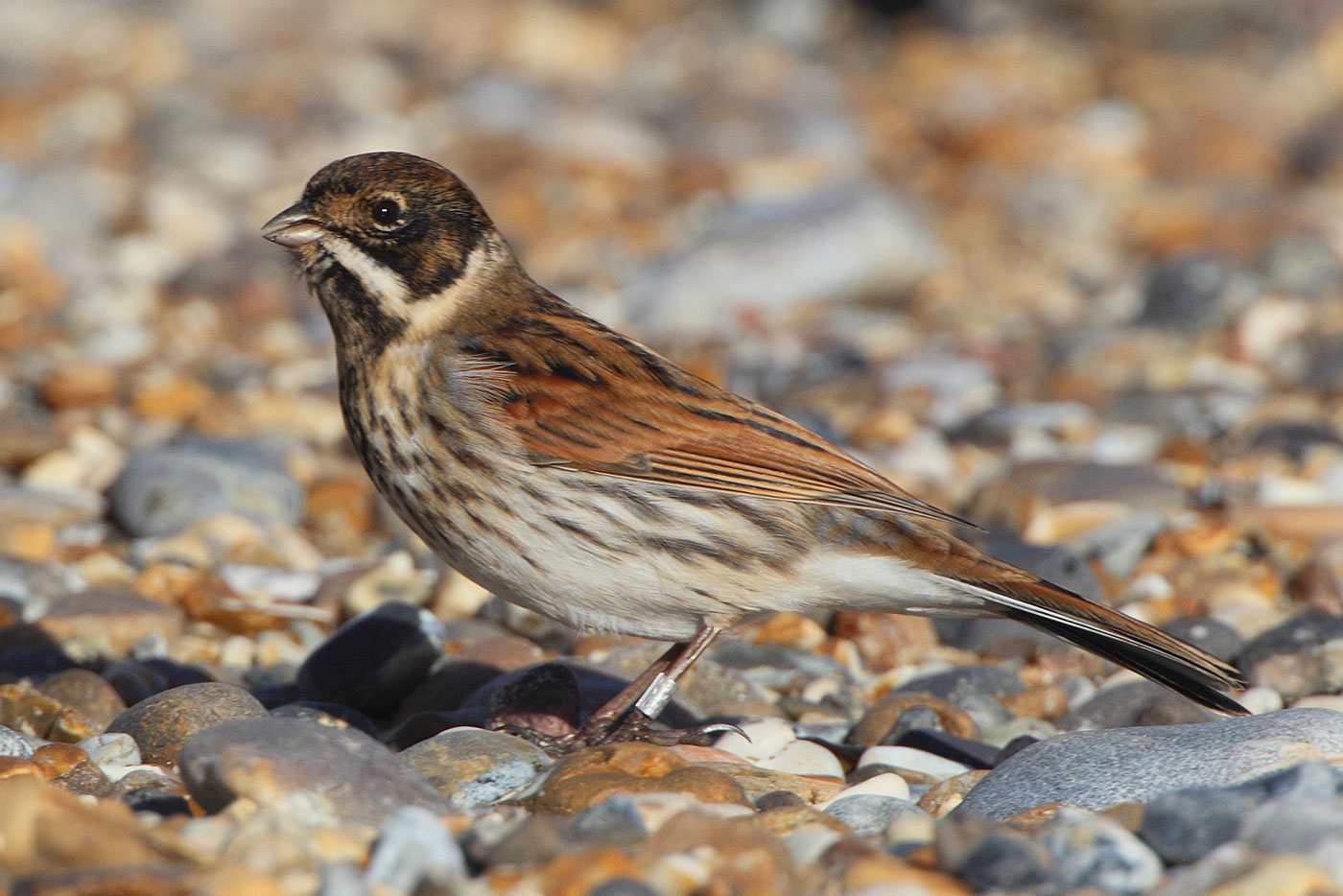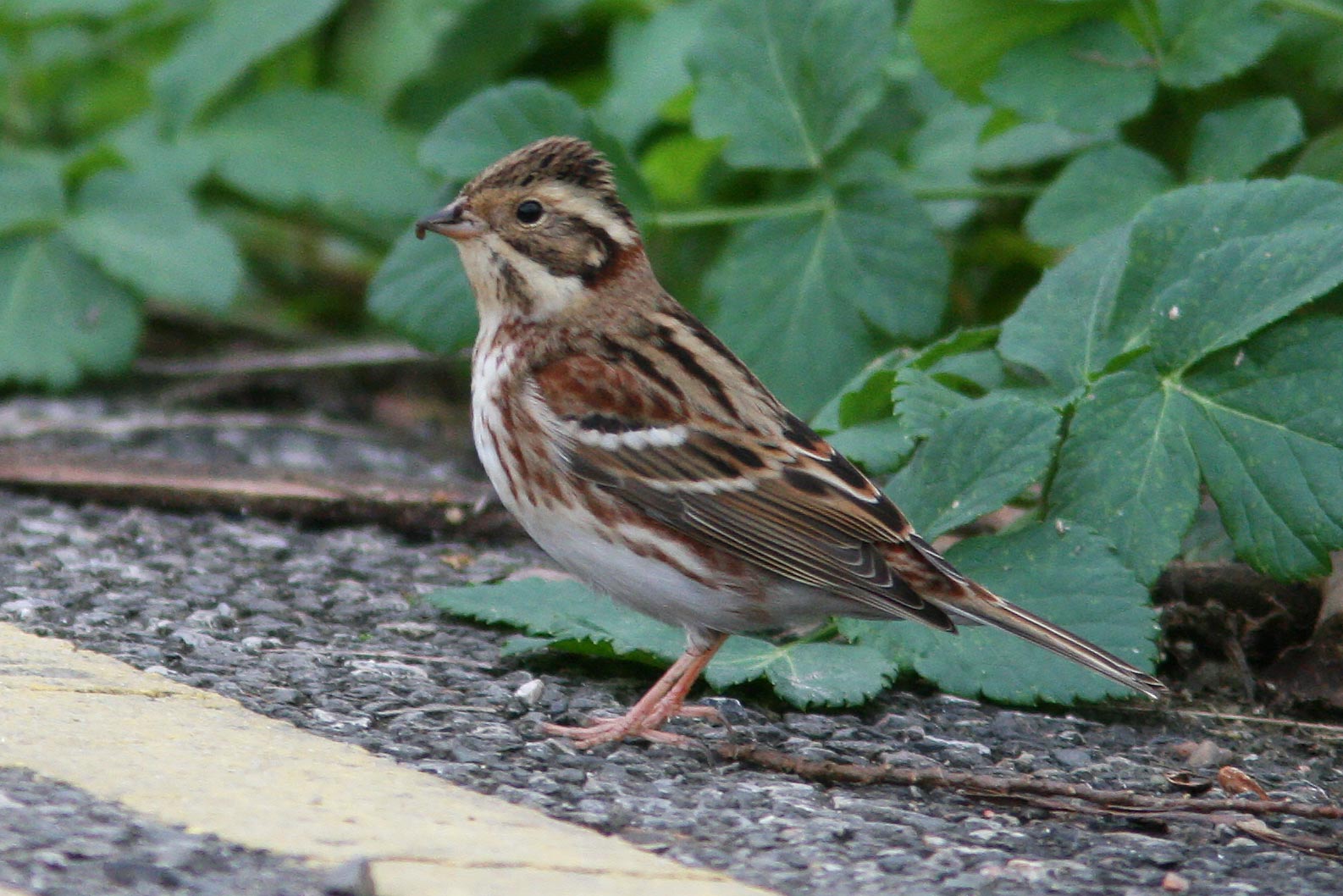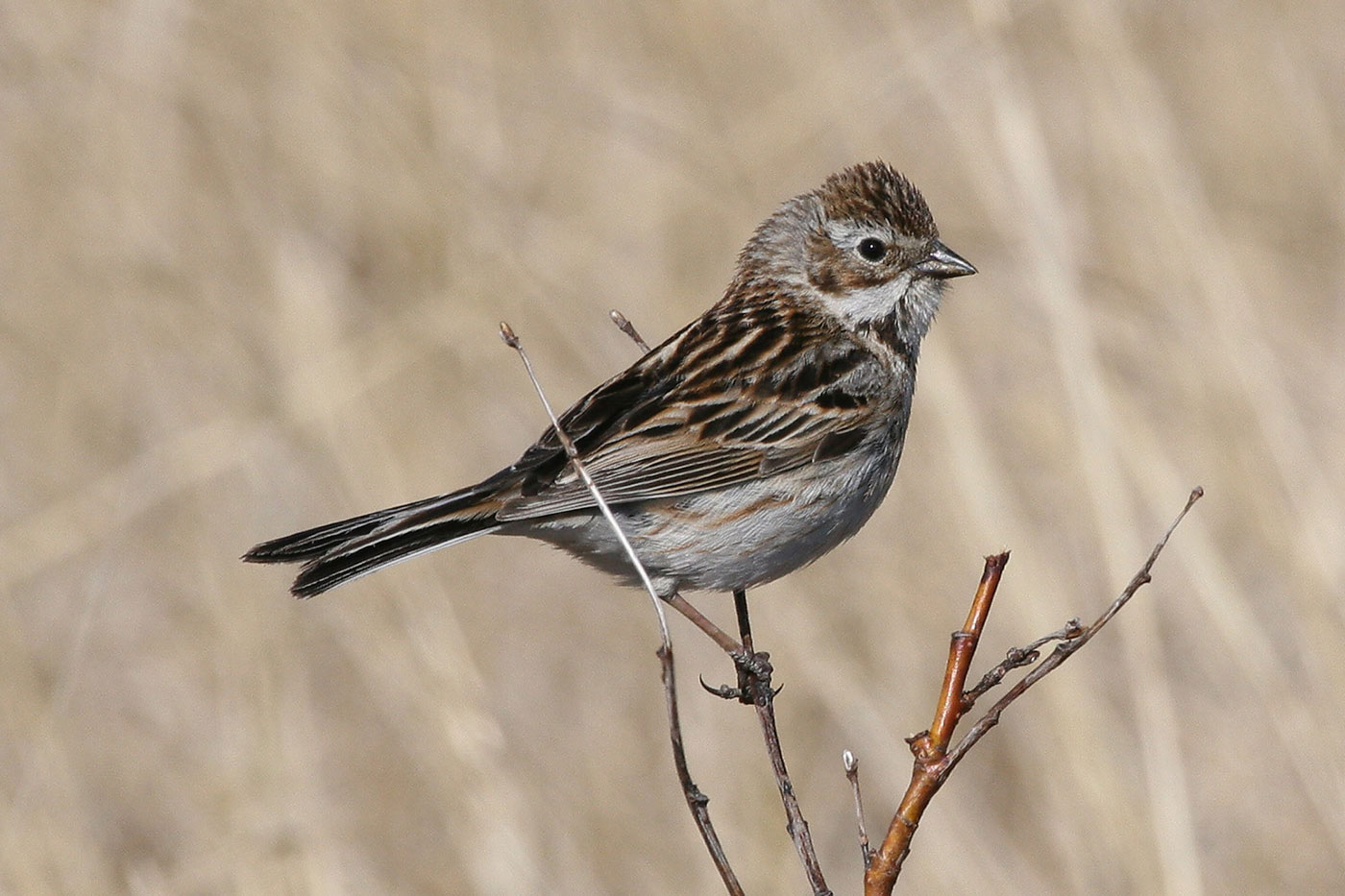Small brown buntings can be a troublesome group, and no more so than in mid to late autumn when the range of possible species is greatest. Here we will focus on the familiar default species, Reed Bunting, and its separation from the most regular of the rare buntings, Little and Rustic. Also included is a brief treatment of two real 'long shots', Pallas's Reed and Chestnut-eared Buntings.

Male Reed Bunting (Tuscany, Italy, 3 November 2009). This charming portrait shows the key features of Reed Bunting to perfection. Most eye-catching are the broad chestnut fringes to the wing and upperparts feathers, but the characteristic head pattern of a black crown, face and throat and white 'moustache' is also starting to emerge from beneath its pale feather tips. With a little more wear, this bird will become fully black-and-white-headed. Also obvious here are a contrasting grey rump and greyish flanks marked with sparse blurry marks (Daniele Occhiato).
Reed Bunting
This is the typical 'brown streaky bunting'. Though the black-headed and snowy-collared males are a familiar sight in spring, singing from prominent perches, females and all autumn birds are much less striking and prefer to skulk away with nervous tail-flicks.
Reed Bunting is common in much of Britain. It usually frequents wetland sites, but can also be found in drier habitats. Although often thought of as a resident, some are more migratory, and autumn influxes to eastern coastal counties (presumably of Continental birds) have long been noted. Such birds can be found in almost any habitat.
Little Bunting
A species with a large world range, Little Bunting breeds in bogs with medium-height birch or pine trees, from Finland in the west to eastern Siberia. It winters predominantly in southern China and northern parts of South-East Asia, with European birds performing a long west-east and then north-south migration to get there.
This is the commonest of the rare buntings in Britain, but it is still an excellent find. It is most regular in Shetland, where it is an expected annual scarce migrant in small numbers in the second half of September and into October. Most autumn records away from Shetland are on the east coast, though Scilly does well, but in the typically denser habitats of mainland Britain this is a hard bird to find.
Wintering birds are regular in tiny numbers, usually well inland or in the west. Spring records are also possible at any time between April and early June, though this is a rare bird at that season.
Rustic Bunting
This species has a similarly large Eurasian range, breeding in wet conifer woodland as far west as Sweden and as far east as the Pacific coast. It winters in Japan, Korea and China, with European birds performing a similar feat of migration to that of Little Bunting.
Rustic Bunting has always been scarcer in Britain than Little. As with the latter, it is perhaps best sought in autumn on the Northern Isles, but Scilly is also a regular venue. Between these poles, however, it is a quality find.
Rustic Bunting occurs more frequently in spring than Little Bunting, a consequence of birds overshooting the breeding grounds. These are best sought in late May and early June, with Shetland again accounting for the vast majority of records. Winter records of Rustic Bunting are very rare.
Pallas's Reed and Chestnut-eared Buntings
Either of these east Asian buntings would be a massive find! The former breeds as close as the northern Urals but, unaccountably, has only occurred in Britain four times: on Shetland, in Sussex and in the North Sea. The latter comes from Manchuria, Korea and the Russian Far East, but has now reached Britain – or more precisely, Shetland – twice, as well as Sweden.
Identification
Familiarity with Reed Bunting is the essential starting point. Though exhibiting a wide variety of plumages, this species has a characteristic long and loose-tailed appearance, an effect heightened by a constant nervous flicking of the tail to reveal prominent white outer tail feathers. Any bird with this 'jizz' will be a Reed Bunting.
The species has a noticeably stubby-looking bill with a slightly convex culmen. A closer look will reveal a bird with strong ginger hues in the scapulars and wing feather fringes (including the lesser coverts), with contrasting greys in the rump and dirty grey-lined flanks. The best clue of all, however, is the call: a high-pitched tseeeu or a strangely jarring dzink.
Little Bunting is small, compact and shorter and thinner tailed. It lacks the nervous tail-flicking of Reed Bunting. Its bill is slim and sharply pointed and the culmen is slightly concave. It is a cleaner white below with clearly defined blackish streaking.
Above it is warm brown rather than ginger, but it is the head pattern that clinches the deal – a beautiful reddish wash to the lores and ear coverts (and often the chin, fore-supercilium and central crown stripe too), strikingly bold white eyerings and a prominent pale spot in the rear of the ear coverts. There is only a little variation according to sex, age and season with, inevitably, spring males being brightest.
The call is a high-pitched insistent tsic, totally different from anything in Reed Bunting's repertoire, but more similar to a long list of Asian 'ticking' buntings.
Rustic Bunting is closer in size to Reed, but is shorter tailed and appears a little larger headed, an effect heightened by its shaggy nape feathers and the suggestion of a slight crest. Its bill is stout and triangular with a straight culmen.
Spring males are bright white below, but the breast is washed reddish-brown, this colour extending onto the flanks as blotchy streaks and also onto the upperparts. Such birds also sport an arresting combination of black or blackish crown, lores and ear coverts, with a white throat and supercilium.
In autumn this is a duller brown bird, but the flanks are still washed in red and there are similar bright hues in the scapulars and rump. The head is dull with a strong buff supercilium and a pale spot in the rear of the ear coverts. This is another 'ticking' bunting and, although its calls are slightly softer and more Song Thrush-like than those of Little Bunting, the differences are not great.
Pallas's Reed Bunting is only likely to be confused with Reed Bunting. It shares that species' long-tailed appearance, but is very small with a short primary projection and, at least in first-winters, is generally paler and frostier with a conspicuous pale buff rump and, most important of all in any plumage, grey (not chestnut) lesser coverts. The call is arresting: a harsh, sparrow-like cheup, totally unlike Reed Bunting.
With its reddish ear coverts and bold white eyerings, Chestnut-eared Bunting resembles a large, long-tailed Little Bunting. However, the red is restricted to the ear coverts, the lesser coverts are rufous, it lacks the crisp crown markings of Little Bunting and its underpart streaking is largely restricted to the upper breast, with the flanks variably washed apricot. This is another 'ticking' bunting.

Male Reed Bunting (Walberswick, Suffolk, 7 November 2012). This more worn individual is almost fully black-and-white-headed and closely resembles the standard field guide image of a male Reed Bunting. The flanks of this bird are a little more heavily and darkly marked, but again the bright chestnut wing and upperparts are very obvious. Note also how the bill looks almost bulbous with a subtly convex culmen (Bill Baston).

Male Little Bunting (Burnham Overy Staithe, Norfolk, 31 October 2012). This bird shows the typical Little Bunting combination of a bright head on a dull body. Turning to the detail, the ear coverts, lores and fore-supercilium are a characteristic reddish colour, while there is also a distinctive crisp white eyering, prominent dark lateral crown-stripes and a pale central crown-stripe. Further clues include dull upperparts with little trace of chestnut, pale brown (not chestnut) fringes to the wing feathers and crisp flank markings on a whitish background. The bill is also quite small and slim with a subtly concave culmen (Robin Chittenden / www.robinchittenden.co.uk).

Male Rustic Bunting (Seasalter, Kent, 21 November 2010). With a well-marked head and dark red washes on the body, this bird would readily catch the eye. The supercilium is long, broad and creamy, the ear coverts strongly 'framed' with a pale area at the rear, while there is also a pale central crown stripe in the raised crest (this is usually flat in the field). Washes of red on the nape, scapulars, breast-sides, flanks, rump and uppertail coverts (the last not seen here) are characteristic of Rustic Bunting, while the bill is typically stout and triangular with a straight culmen (Steve Ray).

Female Reed Bunting (Seaforth, Cheshire, 5 June 2007). This bird shows the overall grey and chestnut hues typical of a female Reed Bunting. The face pattern is not well defined, with just a weak greyish supercilium, while the upperparts and wing feathers are typically strongly washed bright chestnut. The underparts are also greyish and the flanks marked with rather blurry streaking. The characteristic long-tailed appearance of Reed Bunting is shown well here, as is the subtly bulbous bill (Steve Young / www.birdsonfilm.com).

Female Little Bunting (Heuksando, South Korea, 9 May 2009). This female Little Bunting strongly resembles the autumn bird pictured in photo 3, sharing the characteristic red ear coverts, lores and fore-supercilium, but here the red also extends onto the central crown-stripe. Note also the bold white eyering and the largely grey-brown upperparts which have reddish hues restricted to the scapulars, tertials and inner greater coverts. The slim bill is shown well here, as is the somewhat short-tailed look of Little Bunting and its typical creeping, 'low to the ground' posture (Aurélien Audevard).

Female Rustic Bunting (Kuusamo, Finland, 17 June 2005). The reddish hues in the nape, rump, scapulars, breast-sides and flanks are strong evidence that this is a Rustic Bunting. Further confirmation is provided by the bird's strong whitish supercilia, strongly 'framed' ear coverts and bright white underparts. There are plenty of structural clues too – the tail looks short compared with that of Reed Bunting, the head looks heavy with the suggestion of a shaggy nape and the bill is stout and triangular (Jari Peltomaki / www.agami.nl).

Female Reed Bunting (Treffiagat, France, 18 September 2004). This Reed Bunting is typically lacking in strong contrasts. The face pattern is bland and unexceptional, with weak supercilia and poorly marked ear coverts, while the whole of the upperparts and wing feathers are drenched in bright chestnut. Finally, the underparts offer little contrast either, being dull and sullied with blurry streaking. Although often difficult to see, this bird is showing its chestnut lesser coverts – when visible, these are diagnostic of Reed Bunting. Also obvious is the typical long-tailed look of this species (Aurélien Audevard).

First-winter Little Bunting (Fair Isle, Shetland, 10 October 2007). This Little Bunting is showing its features to perfection: a red head contrasting with a dull brown body is an excellent starting point. Looking in more detail, the red ear coverts, lores and fore-supercilium are all clearly visible, along with the dark lateral crown stripes and pale central crown. The upperparts are typically mousey-brown with restricted reddish hues, while the underparts are white with crisp, well-defined blackish streaking, recalling Meadow Pipit. A short-tailed look compared with Reed Bunting and a slim bill complete the identification (Rebecca Nason / www.rebeccanason.com).

First-winter Rustic Bunting (Foula, Shetland, 1 October 2006). This bird shows the typical splashes of reddish on the scapulars, breast-sides and flanks of a Rustic Bunting. It also looks typically short tailed and has its crown feathers raised. Nicely illustrated here are pale pink bubblegum-coloured legs and feet, a feature shared with Little Bunting. Reed Bunting, by contrast, tends to have rather darker, greyish-pink legs and feet (Russell Wynn).

Male Reed Bunting (Kuusamo, Finland, 3 June 2011). This is a typical breeding male Reed Bunting. The pale feather tips on the head have worn away to reveal the diagnostic black head, chin and throat with striking white 'moustache'. As in all Reed Buntings of all ages, the upperparts and wing feathers are liberally washed bright chestnut; the diagnostic chestnut lesser coverts can be seen too. The underparts are also the typical grey with blurry diffuse streaking (Markus Varesvuo / www.birdphoto.fi).

Male Little Bunting (Kuusamo, Finland, 22 June 2004). This stunning male Little Bunting is unmistakable. The red on the head is very bright indeed and here extends onto the chin and upper throat too, while the lateral crown stripes are very dark. The upperparts are grey-brown with, as usual, reddish hues confined to the scapulars, inner greater coverts and tertials. The grey-brown lesser coverts are just about on view here, too. Other classic features include the white underparts with crisp streaking and shortish tail (Markus Varesvuo / www.birdphoto.fi).

Male Rustic Bunting (Kuusamo, Finland, 17 May 2011). This male Rustic Bunting is also pretty unmistakable. The reddish hues in the nape, scapulars, breast-sides, flanks and rump are particularly bright, but it is the black crown sides and ear coverts and white central crown and supercilia which really catch the eye. Also apparent are a short tail, stout-looking bill and pink legs. Spring males like this are striking and do occasionally reach Britain, but typical autumn birds are less obvious. (Markus Varesvuo / www.birdphoto.fi).

Pallas's Reed Bunting (Chukotka, Russia, 8 June 2007). Separating this extreme rarity from Reed Bunting is a challenge, although the small size and sparrow-like call of Pallas's Reed may grab the attention. Typically, this bird looks a little 'frosty' with reduced chestnut in the upperparts and wing feathers and a neat dark area in the lower rear corner of the ear coverts, but the real clincher is visible here in the form of lead grey lesser coverts – these are always bright chestnut on Reed Bunting (James Gilroy).

Chestnut-eared Bunting (Fair Isle, Shetland, October 2004). With its reddish ear coverts and big pale eyering, this bird might suggest Little Bunting, but the otherwise bland face lacking a strong supercilium and lateral crown-stripes is wrong for this species. Other clues that this is no Little Bunting are the warm buffy hues in the closed wing, the peachy wash to the underparts, the lack of prominent black flank streaking and a curiously short primary projection (Rebecca Nason / www.rebeccanason.com).
- This article was originally published in the October 2013 issue of Birdwatch magazine.







